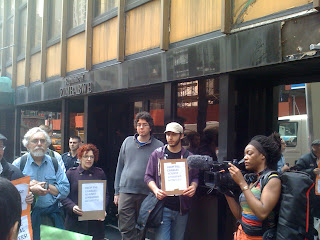This shameful address is about a half block from the building where I live on E. 56th Street. Walking past it you'd think it was a derelict waiting for a wrecking ball. The street level windows are either blacked or covered in chipped reflector sheets. I've never seen anybody go in or out.
On the dark strip above the blank facade, it says "Republic of Zimbabwe" in letters so faded and worn that it looks like the real sign was taken down years ago and all that's left is the outline of the letters. All in all, it's just the sort of place where you'd expect to find the consulate of a government that has to wear a bag over its head when it goes abroad.
The "Republic" of Zimbabwe is one of the sad places in our world where an entire people is held hostage by its so-called government, a corrupt and barbaric entity consisting of the so-called president, Robert Mugabe, and his loathsome clique of military, police, and their favored private sector cronies, all feeding greedily on the resources of the land and its miserable occupants.
The world doesn't pay much attention because the regime does its brutal best to strangle news about what really goes on there. Among the tools it uses is a national law that gives authorities the right to control and suppress the few news organizations that manage to operate in Zimbabwe, both domestic and foreign.
 Rather than accept the terms of the statute, AP decided many years ago to close its bureau in Harare and cover the country with a combination of courageous local freelancers and listening posts in neighboring countries. That hasn't stopped the regime from hounding those journalists, especially at election time, with home invasions, detentions, searches, brutal interrogations and threats of worse.
Rather than accept the terms of the statute, AP decided many years ago to close its bureau in Harare and cover the country with a combination of courageous local freelancers and listening posts in neighboring countries. That hasn't stopped the regime from hounding those journalists, especially at election time, with home invasions, detentions, searches, brutal interrogations and threats of worse.There are certainly blacker holes on the planet. The Mugabe evils are routine and familiar, made more so for me by this closed fist of a building that I often pass on the way to enjoy the flowers in Central Park. I was doing exactly that earlier this month when I encountered these people, the first sign of life I've ever seen around the place.
They were protesting the arrest, detention and torture of 45 people in February for the crime of watching videos of the Arab Spring in Egypt, Tunisia and Libya. In places like Zimbabwe, information is sedition.
I snapped my picture and went on about my business feeling inadequate. Lines from the James Russell Lowell poem "Freedom" came back to me from school days:
True Freedom is to share
All the chains our brothers wear,
And, with heart and hand, to be
Earnest to make others free.


